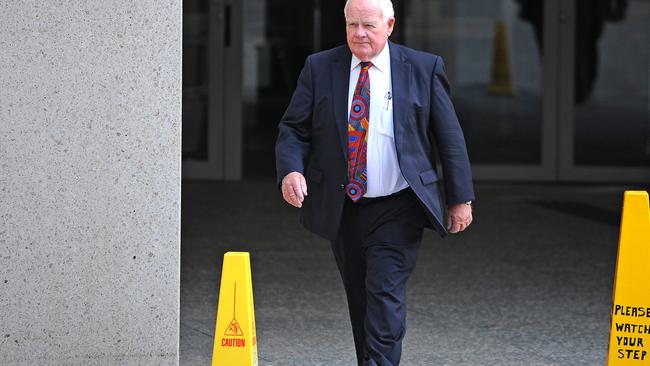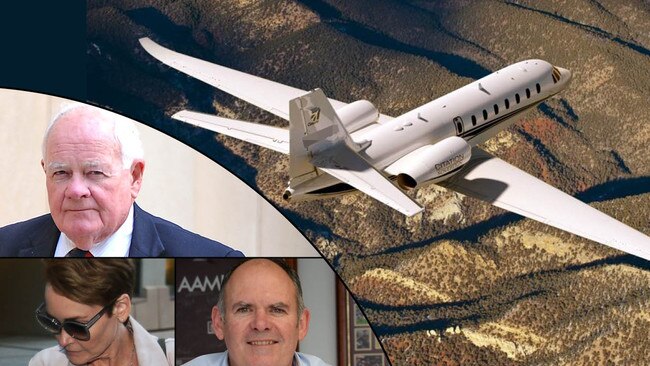HOW could one of Queensland’s most respected building firms, favoured by government and highly accredited in the construction industry end up collapsing owing $50 million and putting more than 200 people out of work?
A public examination in the Federal Court by the liquidator of JM Kelly Group has resulted in explosive claims about the Rockhampton-based company’s business practices including allegedly lying to the building watchdog about its finances, falsifying a contract and paying select creditors while leaving others unpaid.
For a construction sector reeling from a series of corporate collapses in recent years, the story of JM Kelly raises questions about regulatory oversight in the building sector and the treatment of creditors in an increasingly tough industry.
Court freezes JM Kelly’s assets
JM Kelly collapse: full list of creditors
JM Kelly executive’s X-rated password
THE PLAYERS
JM Kelly founder Geoff Murphy was one of six children and grew up in hard-scrabble circumstances in Toowoomba. After finishing school, he undertook a carpentry apprenticeship working with another tradie called Jack Kelly.
Determined to improve his family circumstances and his future by going into business for himself, he borrowed 50 pounds from Kelly in 1969 to set up a building company.
Family looked to ‘take every cent’ out of troubled J.M. Kelly Group
Key figures behind the $33m failure of construction business face questions in court
JM Kelly founder took six-figure salary before $50 million collapse
Kelly owned a percentage of the company and it was called ‘JM Kelly’. Later Mr Murphy’s son John and daughter Elizabeth joined the company.

Elizabeth, a trained accountant who had worked in London, took on the role of financial controller in the 1990s while John became general manager after completing an apprenticeship with the company.
J.M. Kelly director John Murphy grilled in court over $2m in loans
JM Kelly underestimated debt to building watchdog
By the time Jack Kelly exited the business in the 1990s, JM Kelly was a substantial business building schools, hospitals and shopping centres.
Geoff Murphy at one stage was rated as one of central Queensland’s wealthiest men and the company boasted a grazing property, a corporate jet, a sand-dredging business, a cabinet manufacturer and upmarket city unit in Brisbane.
THE QBCC
By 2016 cracks were starting to appear in the JM Kelly empire amid a general downturn in the construction sector. Geoff Murphy told the ABC in 2015 that the company had experienced “one of the worst years I have seen and I’ve been in the business for 50 years.” In 2016, several JM Kelly companies went into administration and Geoff Murphy stood down as a director, leaving John Murphy in effective control of the surviving companies in the group. The state’s building watchdog, the Queensland Building and Construction Commission (QBCC), became increasingly nervous about the financial health of one of the state’s highest profile construction companies. It launched an audit into JM Kelly to see if it was financially healthy enough to retain its building licence. It was then, according to allegations raised in the Federal Court, that key figures within the JM Kelly Group “systematically pedalled lies and half truths” to the QBCC about its finances.

Barrister Craig Wilkins, acting for liquidator Derrick Vickers of PwC, alleged that John Murphy provided one set of financial records to the QBCC while at the same time signing another set of records. Mr Wilkins alleged that the records provided to the QBCC were more favourable than the set he had signed as a true and correct record on the same day. Mr Wilkins also accused Mr Murphy’s sister Elizabeth, the financial controller, of lying to the QBCC about its debt levels, lowering the amount by $1 million instead of increasing it.
Both Elizabeth Murphy and John Murphy deny they lied or misled the QBCC and said the watchdog had given them an unreasonable deadline to provide the financial figures. There was certaintly no love lost between the QBCC and the Murphy family. Elizabeth Murphy admitted she created a computer password that was “f--kqbcc” and blamed the watchdog for the company’s ultimate demise by cutting it off from government contracts.
THE CREDITORS
JM Kelly collapsed owing hundreds of creditors anything from a few thousand dollars to six-figure sums. But according to evidence in the Federal Court, J.M. Kelly Group in 2016 planned to pay a select group of subcontractors and suppliers $3 million while leaving others unpaid. After several J.M. Kelly companies were forced into liquidation in 2016 a surviving firm in the group decided to take on loss-making projects including a new facility at the Rockhampton Hospital. Barrister Craig Wilkins said as part of that arrangement a select list of creditors to be paid was drawn up. Elizabeth Murphy said the list was drawn up by the accounting staff after they were bombarded by phone calls from unpaid suppliers. She denied her father Geoff Murphy and brother John, now the group managing director, made the decision about who would be paid and who would not. “We needed to maintain relationships with clients and suppliers,” she said.

THE SALARIES
Geoff Murphy, the 78-year-old founder of the J.M. Kelly Group, was entitled to a six-figure salary in the three years leading up to the collapse of the company. According to tax returns tendered as evidence in the Federal Court, Mr Murphy was paid $167,248 in 2016, $173,812 in 2017 and a partial payment of $66,000 in 2018. And when the group collapsed Mr Murphy put in a claim of $1.5 million in unpaid holiday pay, salaries and loans. “I never took holiday pay and did not take a salary for several years,” Mr Murphy told the court. Separately, barrister Craig Wilkins accused Helen Rewald, another sister of John Murphy, of “taking every cent” she could out of the company for her expenses in the months before its collapse. Mr Wilkins said Ms Rewald organised reimbursement of leave entitlements, superannuation and other expenses for herself, husband and son from JM Kelly Management, the main financial arm of the group, in the months before its collapse. “You made a point of taking every cent” out of the company, said Mr Wilkins. Ms Rewald denied she knew the company was about to go into liquidation.
THE PLANES
JM KELLY owned and operated two aircraft from a purpose-built hangar at Rockhampton Airport. The first was a Cessna Citation business jet that operated under the tail number VH-JMK. A plane spotter granted access to the JM Kelly hangar in 2013 noted the aircraft’s luxurious interior. The second plane was a twin-engine Cessna 310.
The man in charge of the company’s aircraft was Anthony Murphy, another son of Geoff Murphy. A carpenter turned pilot, Anthony told the Federal Court that he “managed the aircraft” from about 2011 but left the company in 2013 to pursue a business and legal career.
Both planes have now been sold. The Cessna jet was sold to an aero club in Papua New Guinea in 2016 for US$850,000 while the smaller Cessna aircraft was sold at a liquidation auction in February.

THE LOANS
The JM Kelly Group operated something akin to a money “washing machine” that facilitated more than $2 million in loans to heavily-indebted related firms, according to Mr Wilkins. The Federal Court heard that ransfers in 2017 from J.M. Kelly Builders, the main operating arm of the construction group, were made to other companies within the group that had negative assets on their balance sheet of more than $10 million. Mr Wilkins told the Federal Court that figures provided by John Murphy to the QBCC showed debts totalling only $253,000 in 2017 when it fact it was $2.15 million. He said if the true inter-company debt level of the group was known the company would not have qualified to hold a building licence. “The information you provided was inaccurate,” Mr Wilkins told Mr Murphy. “It was not just a little inaccurate but a lot.” Mr Murphy told the court that he did not prepare the report to the QBCC and denied a suggestion from Mr Wilkins that the figures had been “concocted.”

PINK LILY SANDS
The Federal Court heard allegations that Elizabeth Murphy falsified and backdated a haulage contract to benefit a transport company run by her brother in law. Mr Wilkins said that Ms Murphy allegedly backdated the contract to mislead a prospective purchaser of the group’s dredging business Pink Lily Sands that a long-standing written contract was in place with a company called RMR Transport. Ms Murphy’s brother-in-law Brett Rewald is a director of RMR Transport. The contract stated that J.M. Kelly Builders had a five-year agreement with RMR Transport for Pink Lily Sands that had been purportedly signed on July 1, 2016.
Mr Wilkins said the contract had in fact been created in 2018 as the group prepared to sell Pink Lilly business to Rockhampton-based quarry business Hopkins Brothers. Ms Murphy denied she had created a false document to mislead Hopkins Brothers and the “purpose of creating it was to put in writing the verbal agreement.”
THE LIQUIDATOR
THE Supreme Court has now frozen the assets of both Elizabeth and John Murphy as the liquidators move to sue them for more than $9 million. The combined claim for damages of $9.26 million relates to losses allegedly resulting from providing misleading advice about the financial health of the group to the QBCC. The freezing order applies to properties owned by John Murphy, including two houses in the Rockhampton suburb of Park Avenue and a unit in the Empire Apartment building in the central Queensland city. A house in Yeppoon jointly owned by Elizabeth Murphy and several of her siblings also is the subject of the order. The liquidators claimed the Murphys breached their duties under the Corporations Act by providing incorrect financial figures to the QBCC as part of the audit into whether the company could retain its building licence, according to the court documents. The QBCC was told in June 2016 that J.M. KellyBuilders had net tangible assets of $5.623 million when the correct figure was a liability of more than $150,000.
INVESTIGATION CONTINUES
The public examination in the Federal Court will resume in October with John Murphy again slated to give more evidence into collapse of the company his father once boasted he had put “all my heart and soul and everything I ever had into.”


Society has forgotten what makes a hero. We’re here to remind you
The fame of the battlefield warrior has diminished to such an extent that last week’s Married At First Sight contestant sadly commands more admiration. WELCOME TO HIGH STEAKS
I’m a granddad in my 30s. These two moments made me cry
He faces a barrage of questions but refuses to sugar-coat the answers when it comes to what it’s really like being a grandfather in his 30s.